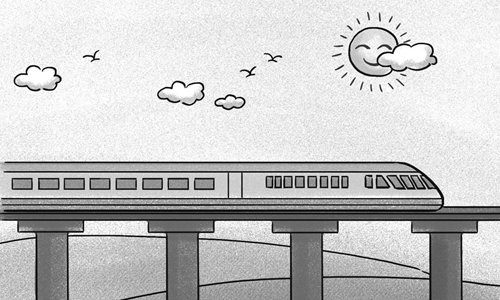HOME >> BUSINESS
Indonesian high-speed rail serves as BRI enlightener
By Li Qiaoyi Source:Global Times Published: 2019/7/25 20:08:40

Illustration: Xia Qing/GT
The delayed rail linking Jakarta and Bandung, a landmark project along the sea route part of the China-proposed Belt and Road Initiative (BRI), could well enlighten the minds of other Chinese businesses readying themselves for a BRI-enabled future.
Winning a bid to capitalize on BRI-powered opportunities is merely the first mile of a long run that requires enormous efforts to iron out various difficulties along the way. In the case of the rail project that's envisioned to catapult Indonesia into becoming the first country in Southeast Asia to join the bullet train club, obstacles include land clearance and construction approval, among others.
The Chinese side, which holds a 40 percent stake in the China-Indonesia joint venture designed to build and operate the rail, has hit difficulties with the project. Given an eagerness to export China's high-speed rail expertise and exemplify the nation's BRI commitments, any tackling of these difficulties should be accompanied by a more nuanced approach to capitalize on opportunities prevalent in markets along the routes.
As a frequent traveler shuttling between domestic cities on high-speed trains, I was stunned to learn that a three-to-four hour drive between Bandung and Jakarta should induce feelings of good luck, as it could take more than 10 hours in case of a traffic jam, and still the rail project that will cut the travel time between the two metropolises to only 40 minutes seems to have been tepidly received.
It's been over three years since Indonesia broke ground on the 142.3 kilometers-long railway and it was not until May 31, 2018 that KCIC, the project consortium composed of four Indonesian companies and five Chinese firms, signed an order to officially commence the project on June 9, 2018. If everything goes as planned, the rail would be finished in 36 months. That suggests the rail opening might be expected in 2021, well behind the initial schedule of beginning operation in 2019.
The hold-up, believed to be largely attributed to complicated and lengthy land acquisition, appears to have not been fully anticipated by the Chinese consortium.
Based on information I got from a meeting in Bandung with the management of the Jakarta-Bandung high-speed rail project of China Railway Group Limited (CREC), one of the five Chinese companies, handover of the land for the project was at only 76 percent as of July 19, and demolition of a portion of the land having been handed over is yet to be done, hampering construction.
Apart from the issue of land acquisition, a variety of construction approvals also stand in the way of the rail project. The Tegal Luar station, one of four stations on the high-speed railway, and a depot in Tegal Luar are still dealing with construction permits, according to CREC, which also cites difficulties with gaining official approval to import materials used in roadbeds, bridges and tunnels for the rail.
While some of the problems might be unpredictable, others could have been foreseen. A typical example of construction delays in Indonesia is the Japan-funded subway in Jakarta, the capital city that's home to about 10 million people. The project intended to help gridlocked Jakarta was initially planned in the 1980s, but construction of the transit line only kicked off in 2013 and the 16 kilometer line finally opened this March. The astonishing delay, in part due to red tape and land clearance, certainly points to conditions pertaining to the nation that are supposed to be taken into account while making investment decisions and negotiating the business and legal terms of contracts so as to minimize cost and time overruns.
This matters a lot for BRI deals that are on many occasions clinched between governments, which could hit roadblocks when being actually implemented. The discrepancies between local governments and the central government in Indonesia as regards land acquisition and construction approval are not rare in markets along the BRI routes, thereby highlighting the need to do your homework before embarking on the venture.
CREC's localization drive, the glittering part of the high-speed rail story, is also worth considering. The contractor now has 659 Chinese staffers working on the Jakarta-Bandung high-speed rail project, while Indonesian employees it has hired for the project hit 2,568, per figures it provided. Many of the Chinese management I met can speak basic Indonesian, which they said was partly thanks to training courses arranged by the company.
The two-way training devised to acquaint Chinese staffers with local rules and cultures and to equip Indonesian employees with various occupational skills goes beyond the rail project. The localization push, as such, will over time translate the high-speed rail into a business card on the move of BRI projects linking China and economies along the routes.
The author is a reporter with the Global Times. bizopinion@globaltimes.com.cn
Posted in: INSIDER'S EYE